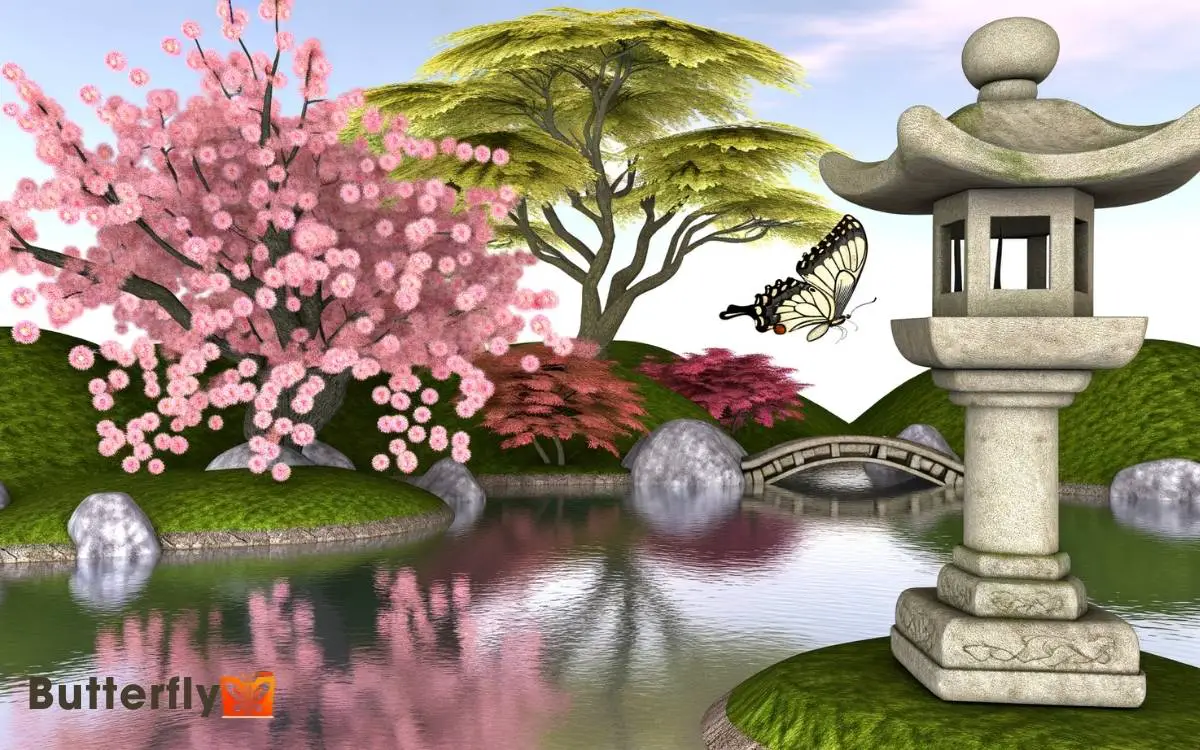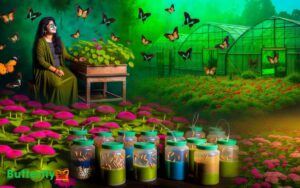How Do You Say Butterfly In Japanese? chō’ (蝶)!
In Japanese, you say butterfly as ‘chō‘ (蝶). The hiragana version is ‘ちょうちょう‘ (chōchō), and the katakana is ‘チョウチョウ‘ (chōchō).
Precise pronunciation involves elongating the ‘o’ sound as in ‘choh’. The kanji 蝶 combines various radicals signifying insect and nature. This term reflects rich cultural symbolism, particularly transformation and beauty.
For accurate pronunciation, focus on sustaining the vowel sound. This word and its profound meanings are also prevalent in literature and art. You’ll uncover more fascinating insights as you explore further.

Key Takeaways
The Japanese Word for Butterfly
In Japanese, the word for butterfly is ‘chō‘ (蝶). You’ll find this term widely used in literature, art, and even modern technology.
The character 蝶 is composed of 虫 (insect) and 翔 (to soar), symbolizing both its essence and elegance. When learning Japanese, understanding the roots and components of kanji can enhance your grasp of the language.
This specific word, ‘chō,’ is often used metaphorically to signify transformation and beauty. Moreover, its presence in various cultural contexts makes it a versatile term.
Pronunciation Guide
To accurately pronounce ‘chō‘ (蝶), you’ll need to focus on the sounds ‘cho’ as in ‘chocolate‘ and elongate the ‘o’ sound. Begin by producing the ‘ch’ sound, similar to the start of ‘chocolate,’ ensuring it’s crisp and clear.
Then, shift smoothly into the long ‘ō’ sound by holding the vowel slightly longer than usual, creating a sustained pitch. Practice by breaking it down: ‘choh.’ Pay attention to maintaining an even tone and avoid letting the vowel dip or rise in pitch unexpectedly.
Repetition of these steps will enhance your pronunciation. Remember, the key lies in the elongation and consistency of the vowel sound to achieve an authentic ‘chō’ pronunciation.
Kanji Characters Explained
Kanji characters often convey complex meanings through their intricate designs, and the character for ‘butterfly’ (蝶) is no exception. This kanji is composed of three main components, each contributing to its overall meaning and aesthetic.
- Insect Radical (虫): This element signifies the character’s connection to insects, grounding it in the natural world.
- Leaf Radical (艹): Representing growth and nature, this radical adds a layer of organic beauty to the character.
- Sound Component (世): This part influences the pronunciation, linking the character to the spoken word.
Understanding these components helps you appreciate the depth and artistry of kanji. By analyzing each element, you see how they combine to create a rich, multifaceted symbol, embodying both meaning and sound.
Hiragana and Katakana Versions
While the kanji for ‘butterfly’ offers a deep, artistic expression, its hiragana and katakana counterparts provide simpler, phonetic alternatives.
In hiragana, ‘butterfly’ is written as ちょうちょ (choucho). The use of hiragana makes the word approachable and easy to read, especially for beginners. In Japanese, each hiragana character represents a syllable, which helps learners pronounce words smoothly. If you ever wonder “how many syllables in butterfly,” in English it has three, while in Japanese, ちょうちょ (choucho) has four due to the distinct sounds of each character. This difference highlights how syllables vary between languages and writing systems.
On the other hand, in katakana, it’s written as チョウチョ (choucho). Katakana often denotes foreign words or emphasizes certain terms, adding a modern touch. Both scripts represent the same pronunciation, but choosing between them depends on context and stylistic preference.
Mastering these forms allows you to adapt your communication, ensuring clarity and appropriateness in various settings. Embrace these versatile scripts to enhance your Japanese language skillset dynamically.
Historical Context
To understand how the word for butterfly evolved in Japanese, you should consider its ancient symbolism, where butterflies often represented the soul or transformation.
Examining Japanese folklore reveals butterflies as messengers of the spirits, linking the natural and spiritual worlds.
Additionally, the cultural significance of butterflies has shifted over time, reflecting changes in societal values and artistic expression.
Ancient Japanese Symbolism
In ancient Japanese culture, the butterfly symbolized transformation, elegance, and the soul’s journey. Understanding these symbols can deepen your appreciation for Japanese art and literature.
Butterflies often appeared in various forms, each carrying distinct meanings.
- Transformation: Much like the metamorphosis of a butterfly, this symbol represented personal growth and change, reflecting life’s impermanence.
- Elegance: Butterflies were admired for their delicate beauty, embodying grace and refinement. They appeared frequently in kimono designs and tea ceremonies.
- Soul’s Journey: Representing the human soul, butterflies were often used in rituals to honor the deceased, signifying the soul’s passage to the afterlife.
Butterfly in Folklore
Building on the ancient symbolism, butterflies in Japanese folklore often embody deep spiritual and moral lessons, weaving their way through tales of transformation and mystical encounters.
These delicate creatures are not merely decorative elements but are pivotal in conveying messages about life, death, and rebirth.
| Folklore Aspect | Details |
|---|---|
| Transformation | Butterflies symbolize personal growth and change. |
| Spirituality | They act as messengers between the spiritual domains. |
| Mystical Encounters | Appearances often herald significant events. |
| Moral Lessons | Stories highlight virtues like perseverance. |
You’ll find that butterflies often appear in stories to guide characters through their journeys, offering wisdom and insight. This rich tapestry of folklore underscores the butterfly’s enduring presence in Japanese culture, capturing imaginations through vivid, transformative narratives.
Cultural Significance Changes
Over the centuries, the cultural significance of butterflies in Japan has evolved, reflecting shifts in societal values, religious practices, and artistic expressions. Initially, butterflies were seen as souls of the departed, a belief tied to Shinto traditions.
This perception gradually transformed:
- Edo Period (1603-1868): Butterflies became symbols of joy and the ephemeral nature of life, often depicted in ukiyo-e art.
- Modern Era: With the influence of Western culture, butterflies now symbolize freedom and transformation, aligning with contemporary values.
- Current Trends: In digital and pop culture, butterflies are popular motifs in fashion, design, and technology, representing innovation and beauty.
These changes highlight how cultural symbols adapt to new contexts and societal shifts, enriching Japan’s cultural tapestry.
Cultural Significance
Butterflies hold deep symbolic meanings in Japanese culture, often representing transformation, beauty, and the soul. You’ll find that these delicate creatures embody the concept of metamorphosis, reflecting personal growth and change.
Their fleeting presence highlights the transient nature of life, a concept deeply ingrained in Japanese philosophy. Traditionally, butterflies are also seen as spirits of the deceased, guiding them to the afterlife, thereby intertwining beauty with a profound spiritual element.
Additionally, two butterflies dancing together symbolize marital happiness and fidelity. In contemporary contexts, butterflies continue to inspire innovation in fashion, design, and literature, making them a timeless icon.
Understanding this cultural significance enriches your appreciation of how butterflies are perceived in Japan, beyond their literal translation.
The Butterfly in Japanese Art
When you explore Japanese art, you’ll notice butterflies frequently appear in traditional Ukiyo-e prints, often symbolizing transformation and beauty.
In paintings, they can signify both joy and the transient nature of life.
Modern artistic representations continue this tradition, using butterflies to evoke themes of change and ephemeral beauty.
Traditional Ukiyo-e Prints
Ukiyo-e prints often feature butterflies as symbols of transformation and ephemeral beauty, reflecting cultural values and artistic techniques of the Edo period.
When you examine these prints, you’ll notice the meticulous detail and vibrant colors that capture the essence of the butterfly’s delicate form. Ukiyo-e artists employed innovative methods to emphasize this symbolism.
- Color Woodblock Printing: Artists used multiple woodblocks to layer colors, creating depth and vibrancy.
- Intricate Line Work: Fine lines were carved to guarantee precision in depicting the butterfly’s wings and patterns.
- Nature Integration: Butterflies were often shown amidst flowers or other natural elements, enhancing the thematic connection to transience.
Symbolism in Paintings
In Japanese paintings, the butterfly often symbolizes the fleeting nature of life and beauty, inviting viewers to reflect on the transitory moments that define human existence. You’ll notice how artists capture the delicate wings and ephemeral flight, emphasizing impermanence.
This symbolism resonates deeply within the context of mono no aware, a Japanese aesthetic that appreciates the poignancy of temporal beauty.
Each brushstroke conveys a nuanced understanding of life’s evanescent qualities. The butterfly’s portrayal alongside flowers or seasonal elements further enhances this theme.
Modern Artistic Representations
Contemporary Japanese artists often incorporate butterflies into their work to explore themes of transformation and renewal. You’ll notice this in various mediums that push boundaries and invite introspection.
For example, contemporary paintings often feature butterflies to symbolize personal growth. Installations may use their delicate forms to create immersive experiences that signify change.
Digital art frequently leverages the butterfly’s metamorphosis to comment on technological evolution.
To fully appreciate these representations:
- Visit Modern Art Museums: Experience butterfly-themed exhibits that highlight innovation.
- Explore Digital Platforms: Discover how digital artists use butterflies to symbolize technological shifts.
- Attend Art Installations: Engage with interactive setups where butterflies represent transformation.
These artistic expressions challenge traditional views, offering fresh perspectives on change and renewal.
The Butterfly in Japanese Literature
Japanese literature often portrays the butterfly as a symbol of transformation and ephemeral beauty, weaving it into stories and poems that reflect the transient nature of life. You’ll find that classic haiku and tanka frequently use butterflies to evoke a sense of impermanence.
Authors like Matsuo Bashō capture this essence through concise imagery: a butterfly’s fleeting presence mirrors life’s momentary nature.
In prose, the butterfly might signify a character’s personal growth or a pivotal change. Natsume Sōseki‘s novel, ‘Kokoro,’ subtly integrates butterflies to symbolize shifts in human relationships.
Symbolism in Japanese Folklore
You’ll find that butterflies in Japanese folklore often embody the souls of the deceased, acting as messengers between the living and the spiritual world. This symbolism is deeply entrenched in various cultural narratives and practices.
- Reincarnation: Butterflies are seen as symbols of reincarnation, representing the soul’s journey through different life stages.
- Protection: Some tales suggest butterflies serve as guardians, protecting the spirits of ancestors and guiding them.
- Transformation: Embodying transformation and renewal, butterflies remind people of the ever-changing nature of existence.
These elements highlight the butterfly’s role in connecting the tangible and intangible, bridging life’s ephemeral moments with eternal truths. By understanding these symbolic meanings, you can appreciate the profound cultural tapestry woven around this delicate creature.
Modern Usage
In modern usage, the butterfly continues to hold a significant place in Japanese culture, appearing in various forms of art, fashion, and even technology. You’ll notice butterflies intricately designed on kimonos, symbolizing elegance and transformation.
In contemporary art, digital illustrations frequently incorporate butterfly motifs to evoke themes of change and beauty. Fashion designers often use butterfly patterns to add a touch of sophistication and grace to their collections.
Additionally, tech companies have adopted the butterfly as a symbol in their branding, indicating innovation and adaptability.
This multifaceted usage reflects the butterfly’s enduring relevance, seamlessly blending traditional symbolism with modern aesthetics, making it a versatile icon in Japanese culture today.
Common Phrases and Idioms
Beyond its aesthetic appeal, the butterfly also finds its way into common Japanese phrases and idioms, where it often conveys deeper meanings related to transformation, fleeting beauty, and the ephemeral nature of life.
Understanding these idioms can enrich your grasp of Japanese culture and language nuances. Here are three notable examples:
- 胡蝶の夢 (Kochou no Yume): This phrase, meaning ‘Butterfly Dream,’ originates from a famous Chinese story and symbolizes the blurred line between reality and illusion.
- 一蝶一花 (Ittou Ikkwa): Translating to ‘One Butterfly, One Flower,’ it represents harmony and interconnectedness in nature.
- 浮世の蝶 (Ukiyo no Chou): Literally ‘Butterfly of the Floating World,’ it refers to someone who lives a fleeting, pleasure-seeking life.
These idioms provide insight into the Japanese worldview.
Learning Through Media
To master the Japanese term for butterfly and its cultural nuances, leverage various media resources like anime, films, and literature for an immersive learning experience. Engaging with different types of media not only enhances vocabulary but also deepens cultural understanding.
| Media Type | Example Title | Key Takeaway |
|---|---|---|
| Anime | “Mushishi” | Explores nature and symbolism. |
| Film | “Spirited Away” | Showcases cultural metaphors. |
| Literature | Haiku Poetry | Delivers concise language and imagery. |
Anime often includes symbolic representation of butterflies, films provide visual and contextual cues, and literature, especially haiku, offers poetic insight.
By integrating these resources into your study routine, you’ll gain a multifaceted understanding of the term and its cultural significance.
Practice and Application
You’ll benefit immensely from practicing the term for butterfly in Japanese through daily conversations and writing exercises. Mastering ‘蝶’ (chō) requires consistent application.
Here’s a structured approach to integrate it seamlessly:
- Daily Usage: Incorporate ‘chō’ in sentences during your daily routine. For instance, ‘I saw a beautiful chō in the garden.’
- Writing Practice: Dedicate a few minutes each day to write sentences using ‘蝶.’ This will reinforce memory and improve writing skills.
- Interactive Tools: Utilize language apps that offer speaking and listening exercises. These tools can provide instant feedback and track your progress.
Conclusion
You’ve now got the tools to let the word ‘butterfly,’ or 蝶 (chō), flutter effortlessly into your Japanese vocabulary. From understanding its kanji roots to recognizing it in hiragana and katakana, you’ve built a solid foundation.
With historical insights and modern contexts, you’re ready to immerse yourself in catching these linguistic butterflies in everyday conversations. Explore media, practice actively, and watch your proficiency soar like a butterfly on a summer breeze.
Keep learning and let your language skills blossom.






